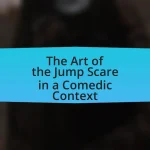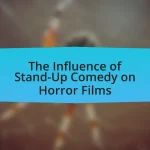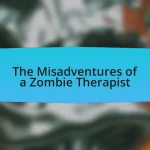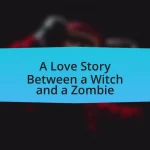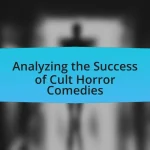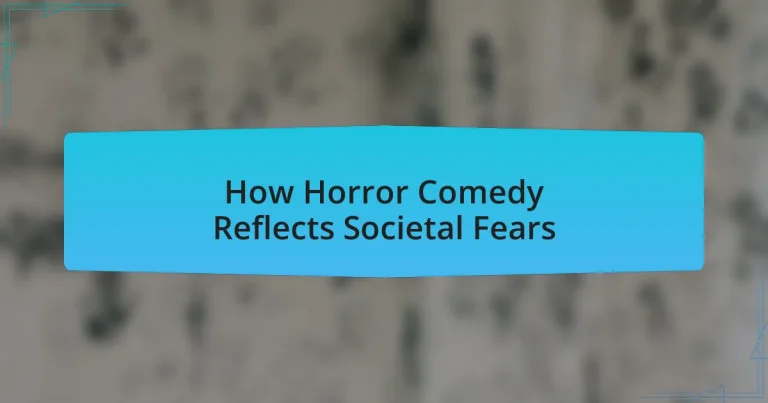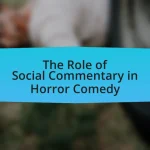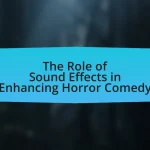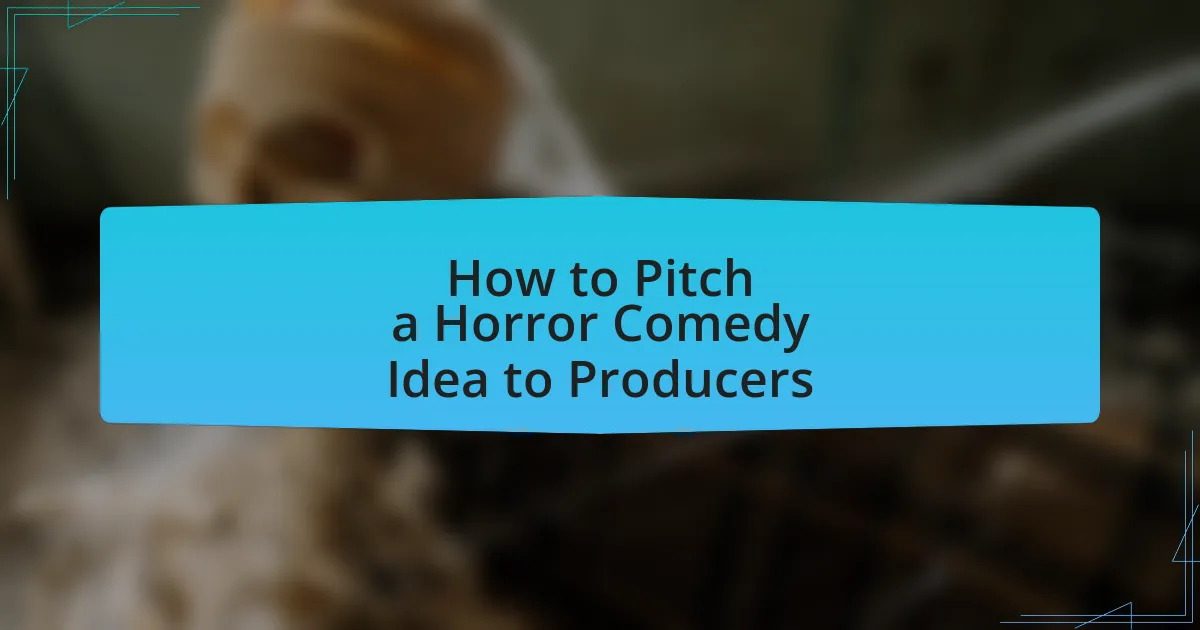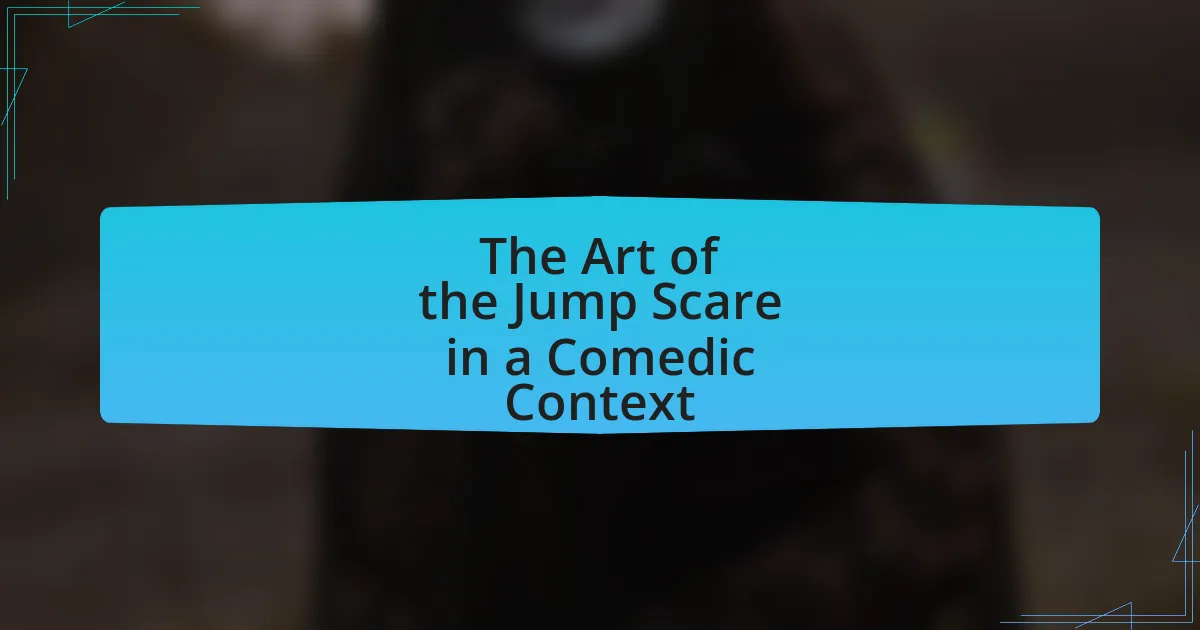Horror comedy is a genre that combines elements of horror and humor to address and subvert societal fears. This article explores how horror comedies, such as “Shaun of the Dead” and “Tucker and Dale vs. Evil,” utilize comedic scenarios to reflect anxieties surrounding mortality, societal collapse, and social norms. Key characteristics of the genre include the blending of exaggerated characters and absurd situations, which allow audiences to confront their fears in a less threatening manner. Additionally, the article examines the role of satire in critiquing societal issues, the psychological effects of horror comedy on audiences, and how these films can spark conversations about contemporary anxieties.
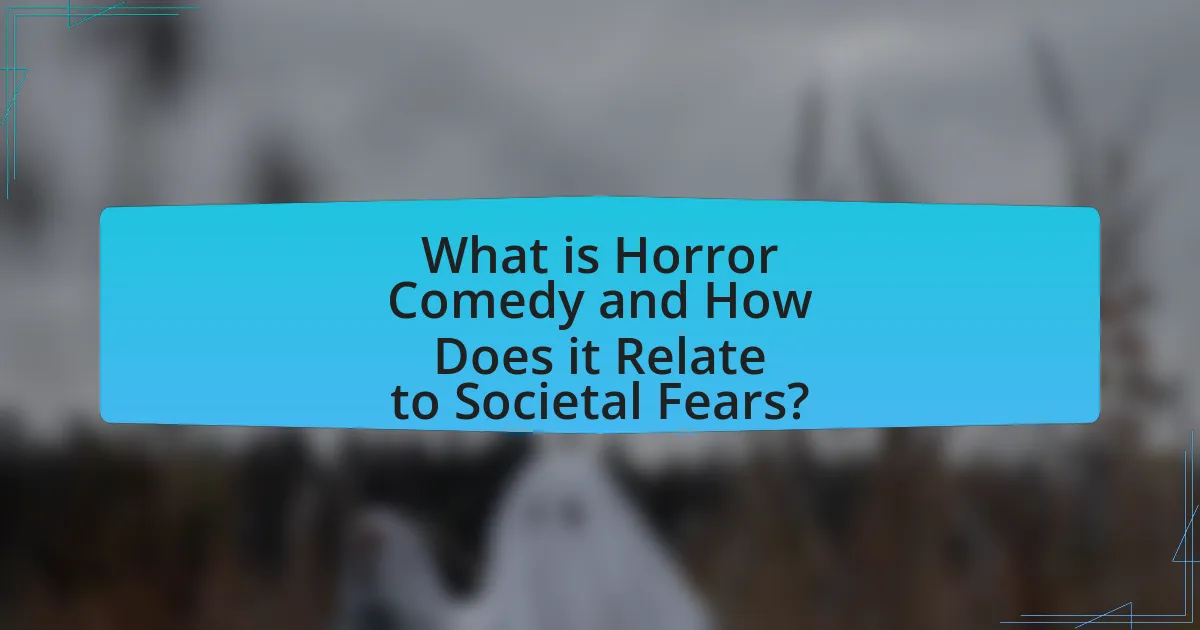
What is Horror Comedy and How Does it Relate to Societal Fears?
Horror comedy is a genre that blends elements of horror and comedy, using humor to address and subvert traditional horror tropes. This genre often reflects societal fears by exaggerating them in a way that allows audiences to confront their anxieties while simultaneously finding humor in the absurdity of those fears. For instance, films like “Shaun of the Dead” and “Tucker and Dale vs. Evil” utilize comedic scenarios to explore themes of mortality, societal collapse, and the irrationality of fear, making these topics more approachable. By presenting horror in a comedic light, horror comedies can critique societal norms and fears, allowing audiences to engage with serious issues in a less threatening manner.
How does Horror Comedy blend humor and horror elements?
Horror comedy blends humor and horror elements by juxtaposing comedic situations and characters with traditional horror tropes, creating a unique narrative dynamic. This genre often employs irony, satire, and absurdity to subvert audience expectations, allowing for laughter in the face of fear. For example, films like “Shaun of the Dead” utilize zombie apocalypse scenarios to explore themes of friendship and societal norms while incorporating slapstick humor and witty dialogue. This blend not only entertains but also provides a lens through which societal fears, such as mortality and the breakdown of social order, can be examined in a less threatening manner.
What are the key characteristics of Horror Comedy?
Horror comedy is characterized by the blending of horror elements with comedic aspects, creating a unique genre that elicits both fear and laughter. This genre often employs exaggerated characters, absurd situations, and dark humor to subvert traditional horror tropes, making the frightening scenarios more palatable and entertaining. For instance, films like “Shaun of the Dead” and “Tucker and Dale vs. Evil” illustrate how humor can diffuse tension and provide commentary on societal fears, such as the fear of the unknown or the absurdity of human behavior in crisis situations. The juxtaposition of horror and comedy not only entertains but also allows audiences to confront their fears in a less threatening manner, highlighting the genre’s ability to reflect and critique societal anxieties.
How do humor and horror coexist in this genre?
Humor and horror coexist in the horror comedy genre by using comedic elements to provide relief from tension, allowing audiences to engage with frightening themes without overwhelming fear. This interplay creates a unique narrative dynamic where humor can highlight the absurdity of horror situations, making them more palatable. For instance, films like “Shaun of the Dead” blend slapstick comedy with zombie horror, illustrating how laughter can coexist with fear, ultimately reflecting societal anxieties in a more approachable manner. This genre often uses satire to critique societal norms, demonstrating that humor can serve as a coping mechanism for confronting deeper fears.
Why is Horror Comedy an effective medium for exploring societal fears?
Horror comedy is an effective medium for exploring societal fears because it juxtaposes humor with horror, allowing audiences to confront and process their anxieties in a less threatening context. This genre often highlights societal issues, such as prejudice, consumerism, or existential dread, using satire to critique and reflect on these fears. For instance, films like “Get Out” address racial tensions through a blend of horror and comedy, making the uncomfortable subject matter more accessible and engaging. By eliciting laughter alongside fear, horror comedy encourages viewers to reflect on their societal concerns, ultimately fostering a deeper understanding of the underlying issues.
What societal fears are commonly addressed in Horror Comedy?
Horror comedy commonly addresses societal fears such as the fear of death, the fear of the unknown, and the fear of societal norms being subverted. These genres often blend humor with horror elements to explore anxieties surrounding mortality, as seen in films like “Shaun of the Dead,” which juxtaposes zombie apocalypse scenarios with everyday life, highlighting the absurdity of human existence. Additionally, horror comedies frequently challenge social conventions, as illustrated in “The Cabin in the Woods,” where characters confront their roles and expectations, reflecting fears of conformity and the consequences of breaking societal rules. This combination of humor and horror serves to both entertain and provoke thought about these underlying societal anxieties.
How does the genre reflect cultural anxieties?
The horror comedy genre reflects cultural anxieties by blending humor with elements of fear, allowing audiences to confront societal issues in a more palatable way. This genre often addresses themes such as existential dread, social alienation, and the absurdity of modern life, which resonate with contemporary audiences facing uncertainty. For instance, films like “Get Out” and “Shaun of the Dead” utilize satire to critique racial tensions and societal norms, respectively, illustrating how humor can serve as a coping mechanism for deeper anxieties. By juxtaposing comedic elements with horror tropes, the genre enables viewers to engage with their fears while simultaneously providing relief through laughter, thus highlighting the complexities of cultural concerns.
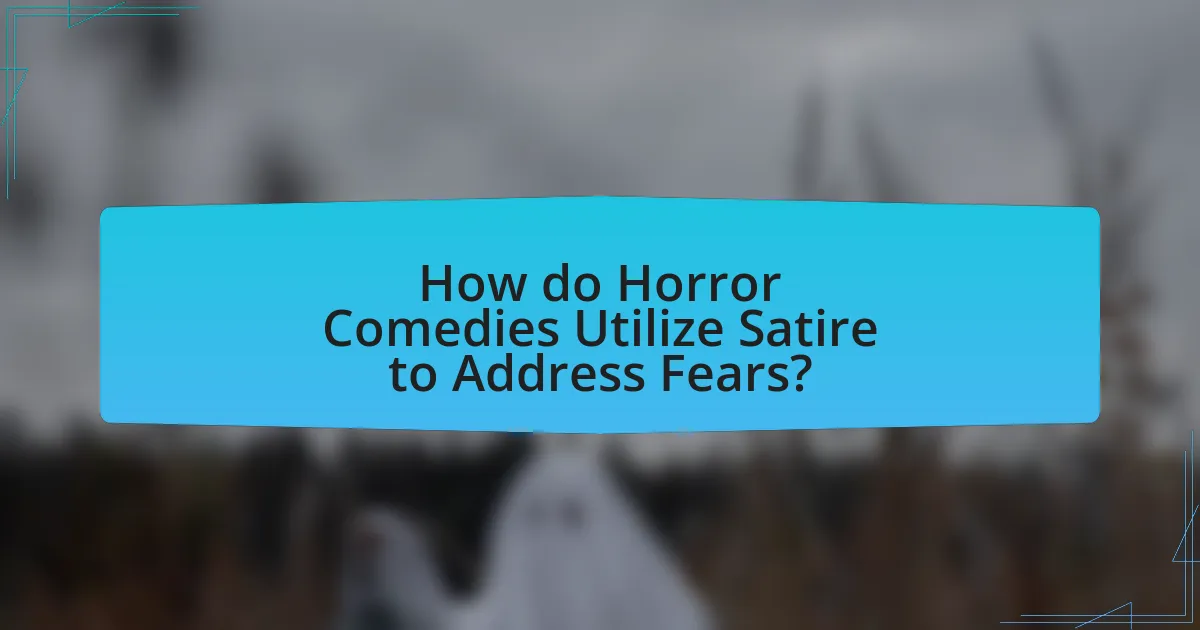
How do Horror Comedies Utilize Satire to Address Fears?
Horror comedies utilize satire to address fears by exaggerating and mocking societal anxieties, thereby transforming them into comedic elements. This genre often highlights irrational fears, such as those surrounding death or the supernatural, by presenting them in absurd or humorous contexts, which allows audiences to confront these fears in a less threatening manner. For instance, films like “Shaun of the Dead” parody zombie apocalypse scenarios, using humor to critique societal behaviors and fears related to consumerism and social isolation. By blending horror with comedy, these films create a space for reflection and discussion about deeper societal issues, making the fears more approachable and digestible for viewers.
What role does satire play in Horror Comedy?
Satire in horror comedy serves to critique societal norms and fears by using humor to expose the absurdities within those fears. This genre juxtaposes horror elements with comedic situations, allowing audiences to confront their anxieties in a less threatening manner. For instance, films like “Shaun of the Dead” highlight the triviality of social conventions amidst a zombie apocalypse, effectively satirizing both horror tropes and societal behaviors. By doing so, horror comedy not only entertains but also encourages reflection on the irrationality of certain fears, making it a powerful tool for social commentary.
How does satire enhance the commentary on societal issues?
Satire enhances the commentary on societal issues by using humor and exaggeration to critique and expose the flaws within social norms and behaviors. This form of expression allows audiences to engage with serious topics in a more approachable manner, facilitating reflection and discussion. For instance, works like George Orwell’s “Animal Farm” utilize satire to comment on totalitarianism and corruption, making complex political issues accessible and relatable to a broader audience. By highlighting absurdities and contradictions in society, satire encourages critical thinking and can inspire change by prompting individuals to reconsider their beliefs and actions.
What are some examples of effective satire in Horror Comedies?
Effective satire in horror comedies includes films like “Shaun of the Dead,” which critiques consumerism and the monotony of modern life through its zombie apocalypse setting. Another example is “Tucker and Dale vs. Evil,” which subverts horror tropes by portraying the supposed villains as misunderstood characters, highlighting societal prejudices and assumptions about rural people. Additionally, “What We Do in the Shadows” satirizes vampire lore and the absurdity of immortality, reflecting contemporary social dynamics and the challenges of modern relationships. These films use humor to address deeper societal fears, making their satire both entertaining and thought-provoking.
How do characters in Horror Comedies embody societal fears?
Characters in horror comedies embody societal fears by exaggerating and satirizing common anxieties, such as the fear of the unknown, social isolation, and the breakdown of societal norms. For instance, films like “Shaun of the Dead” depict characters facing a zombie apocalypse, which symbolizes societal fears of consumerism and loss of individuality. The comedic elements serve to highlight these fears in a way that is both entertaining and thought-provoking, allowing audiences to confront their anxieties while laughing. This duality reinforces the idea that humor can be a coping mechanism for societal issues, making the fears more relatable and accessible.
What archetypes are commonly found in Horror Comedy?
Common archetypes found in Horror Comedy include the Reluctant Hero, the Comic Relief, the Villain with a Twist, and the Innocent Bystander. The Reluctant Hero often embodies an everyman character who is thrust into terrifying situations, reflecting societal fears of inadequacy and unexpected challenges. The Comic Relief serves to lighten the mood, often through humor that highlights the absurdity of fear, showcasing how society copes with anxiety. The Villain with a Twist subverts traditional horror tropes, often revealing a backstory that elicits sympathy, mirroring societal complexities in understanding evil. Lastly, the Innocent Bystander represents the average person caught in extraordinary circumstances, emphasizing the unpredictability of life and the fear of being unprepared for chaos. These archetypes collectively illustrate how Horror Comedy navigates and critiques societal fears through humor and horror elements.
How do these characters reflect real-world fears and anxieties?
Characters in horror comedies often embody real-world fears and anxieties by exaggerating societal issues, such as the fear of the unknown, social isolation, and existential dread. For instance, characters facing supernatural threats can symbolize the anxiety surrounding modern life challenges, like job insecurity or health crises, reflecting how individuals cope with overwhelming situations. Additionally, the comedic elements serve to highlight the absurdity of these fears, making them more relatable and accessible. This duality allows audiences to confront their anxieties in a safe environment, as seen in films like “Shaun of the Dead,” where the zombie apocalypse mirrors societal breakdowns and personal crises.
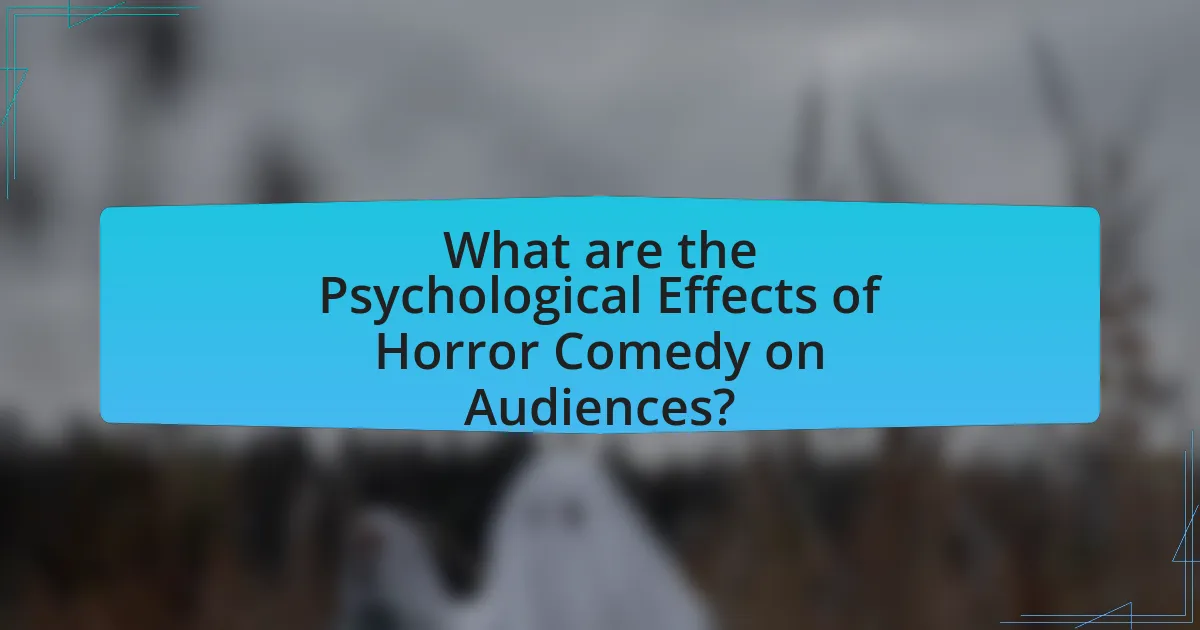
What are the Psychological Effects of Horror Comedy on Audiences?
Horror comedy elicits a unique psychological response in audiences by blending fear and humor, which can lead to catharsis and a reduction in anxiety. This genre allows viewers to confront their fears in a safe environment, facilitating emotional release and resilience. Research indicates that the juxtaposition of horror and comedy can enhance enjoyment and engagement, as humor serves to alleviate the tension created by horror elements. For instance, a study published in the journal “Psychology of Popular Media” by authors such as Paul A. Harris and others found that horror comedies can increase positive emotional responses while simultaneously allowing audiences to process societal fears in a less threatening manner. This dual effect can foster a sense of community among viewers, as shared laughter in the face of fear can strengthen social bonds.
How does Horror Comedy influence audience perceptions of fear?
Horror comedy influences audience perceptions of fear by juxtaposing comedic elements with horror tropes, which can diminish the intensity of fear and create a more palatable experience. This blending allows audiences to confront their fears in a less threatening context, often leading to a cathartic release of tension. Research indicates that humor can act as a coping mechanism, enabling viewers to process fear-inducing scenarios without overwhelming anxiety. For instance, a study published in the journal “Psychology of Popular Media Culture” by authors such as Paul J. Silvia highlights how humor can reduce physiological responses to fear, suggesting that horror comedies can transform fear into amusement, thereby altering audience perceptions.
What psychological mechanisms are at play when audiences laugh at fear?
Audiences laugh at fear primarily due to the psychological mechanisms of incongruity and relief. Incongruity theory suggests that humor arises when there is a mismatch between expectations and reality, which is often present in horror comedy scenarios where frightening situations are juxtaposed with absurd or humorous elements. This unexpected combination triggers laughter as a cognitive response to the surprise. Additionally, the relief theory posits that laughter serves as a coping mechanism, allowing individuals to release built-up tension and anxiety associated with fear. This is evident in studies showing that laughter can reduce physiological stress responses, providing a sense of safety after experiencing fear-inducing stimuli. Thus, the interplay of incongruity and relief enables audiences to navigate their fears in a socially acceptable manner, transforming anxiety into humor.
How can Horror Comedy serve as a coping mechanism for societal fears?
Horror comedy serves as a coping mechanism for societal fears by allowing individuals to confront and process their anxieties in a safe and humorous context. This genre blends elements of horror with comedy, enabling audiences to laugh at what typically frightens them, thereby reducing the emotional intensity associated with those fears. Research indicates that humor can act as a psychological buffer, helping people manage stress and anxiety; for instance, a study published in the journal “Psychological Science” found that humor can mitigate the impact of fear-inducing stimuli. By transforming societal fears into comedic scenarios, horror comedy not only provides entertainment but also fosters resilience and promotes discussions about underlying issues, making it a valuable tool for coping with collective anxieties.
What are the implications of Horror Comedy for societal discourse?
Horror comedy serves as a lens through which societal fears and anxieties can be examined and discussed. By blending humor with horror, this genre allows audiences to confront uncomfortable topics, such as death, violence, and societal norms, in a more palatable way. For instance, films like “Shaun of the Dead” and “What We Do in the Shadows” utilize comedic elements to address themes of mortality and social isolation, prompting viewers to reflect on their own fears and societal issues. This duality encourages open dialogue about taboo subjects, making horror comedy a significant tool for societal discourse.
How can Horror Comedy spark conversations about societal issues?
Horror comedy can spark conversations about societal issues by using humor to address and critique fears and anxieties prevalent in society. This genre often exaggerates real-life problems, such as social injustice, mental health, and cultural taboos, making them more approachable for audiences. For instance, films like “Get Out” highlight racial tensions through a blend of horror and comedy, prompting discussions about racism and privilege. By framing serious topics in a comedic context, horror comedies encourage viewers to reflect on these issues without the heaviness typically associated with them, thus facilitating open dialogue and deeper understanding.
What role does audience reception play in the effectiveness of Horror Comedy?
Audience reception is crucial to the effectiveness of horror comedy, as it directly influences how humor and horror elements are perceived and integrated. When audiences resonate with the comedic aspects, they are more likely to engage with the horror elements, creating a balanced experience that enhances both genres. Research indicates that successful horror comedies often rely on audience familiarity with horror tropes, which allows for comedic subversion of expectations, thereby increasing enjoyment and relatability. For instance, films like “Shaun of the Dead” effectively blend humor with horror by reflecting societal fears, such as the fear of the apocalypse, while simultaneously providing comedic relief that resonates with viewers. This interplay between audience reception and genre elements is essential for maximizing the film’s impact and effectiveness.
What are some practical tips for analyzing Horror Comedy in relation to societal fears?
To analyze Horror Comedy in relation to societal fears, focus on identifying the underlying themes that reflect contemporary anxieties. Examine how the genre juxtaposes humor with horror elements to critique or highlight societal issues, such as fear of the unknown or social taboos. For instance, films like “Get Out” use satire to address racial tensions, illustrating how humor can serve as a coping mechanism for societal fears. Additionally, consider the historical context of the film’s release, as societal fears often evolve; analyzing audience reactions can provide insight into the effectiveness of the humor in addressing these fears.

